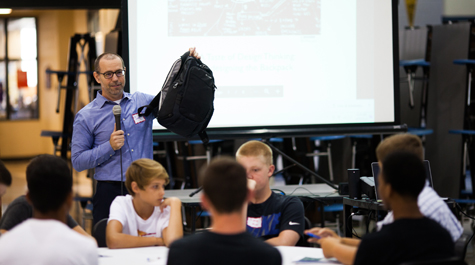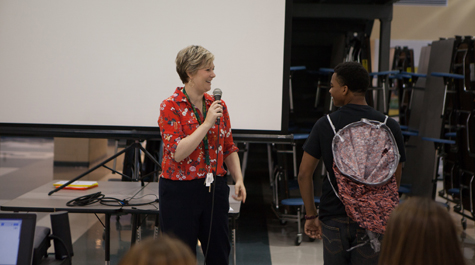Paving a new path in high school education
In the commons area at Warhill High School in Williamsburg, dozens of rising ninth grade students scramble about, racing against a timer to build something out of mundane materials like scraps of fabric, duct tape, pipe cleaner, plastic buckets, belts and their own wild imaginations.
The challenge — to create a more innovative backpack — was being led by Mark Hofer, professor of education, and Lindy Johnson, assistant professor of English education at William & Mary. It was intended to serve as an example of design thinking — a concept these students will come to know very well during their freshman year of high school.
As thousands of kids in the Williamsburg-James City County school district completed the first week of the new year this week, these 100 students embarked on an entirely different adventure. They’re part of a group of students who opted into an alternative curriculum this year called the Pathways Project.
Co-designed by Williamsburg-James City County Public Schools and Johnson and Hofer, co-directors of the W&M School of Education’s new Center for Innovation in Learning Design, the project abandons the typical prescribed high school curriculum and instead allows students to work at their own pace and choose classes and a career direction that interest them.
“Pathways is about finding out what you’re passionate about and what you’re good at, and then figuring out the best way to achieve that goal,” said Johnson. “My sense is that throughout the course of these four years, the students will have a much better idea of what they want to do after high school, because not every kid wants to go to college, so it doesn’t really make sense to push that one-size-fits-all approach onto everyone.”
The Pathways Project came to fruition this year after more than a year of planning. The idea was first born out of a call for applications from the Virginia Department of Education for a high school innovation planning grant. WJCC Public Schools — one of five districts to receive grants in the state — received $50,000 last July to research and develop a curriculum for Pathways. This summer, they received an additional $50,000 grant for implementation.
“We looked a lot at how we could creatively use existing structures to develop sustainable innovation,” said Jeff Carroll, principal of Warhill High School. “So, for example, every 7th grader in this district completes a plan of study that includes identifying one of 16 career clusters [part of a national curriculum] that they’re interested in. So we tied a lot of Pathways to this idea of identifying a career cluster so we could build off of that knowledge and not have to reinvent the wheel.”
The 16 career clusters will be taught to Pathways students in a class called “Design Your On Ramp,” which will give each kid hands-on exposure to many different careers through job site visits and meetings from professionals in each career category.
In addition to a personalized, career-focused curriculum, the students will also be exposed to unique types of teaching that incorporates e-learning, real-world challenges and hands-on training. In the “Humanities by Design” class, which combines English and social studies, students will be participating in a national civic campaign called “Letters to the Next President,” in which they’ll be creating multimedia presentations that ask the incoming president to address certain issues that are important to them.
“Physics by Design,” a class that blends physics with applied math, will utilize design thinking and project-based learning by tasking students with planning and designing their own amusement park.
“High school kids are increasingly disengaged in school because they don’t think what they’re learning is relevant or meaningful to their lives,” said Hofer. “A lot of these projects and the approaches to teaching are intended to directly address that lack of engagement.”
Throughout the year, Hofer and Johnson will be working with Carroll and the Warhill High School teachers involved in Pathways to conduct research on what aspects of the teaching methods are successful and which ones are not in the hopes of fine-tuning the curriculum for the second semester and the following years.
“We’re interested in their engagement, their motivation, their vision for their future, their ability to explore their careers, their confidence in learning online, and any challenges they encounter, because this is going to be new for most if not all of them,” said Hofer.
Hofer and Johnson hope the lessons they learn through the Pathways Project can also help and encourage other schools throughout Virginia to adopt similar programs or aspects of the program.
“This is a huge leap of faith — $50,000 and one year to plan a new high school experience is not much,” said Hofer. “But what has struck me all along is how enthusiastic Jeff and the teachers are, and it’s because of the students. They feel like this is a way to make school a better experience for the students, and to me, that is so inspiring.”



















